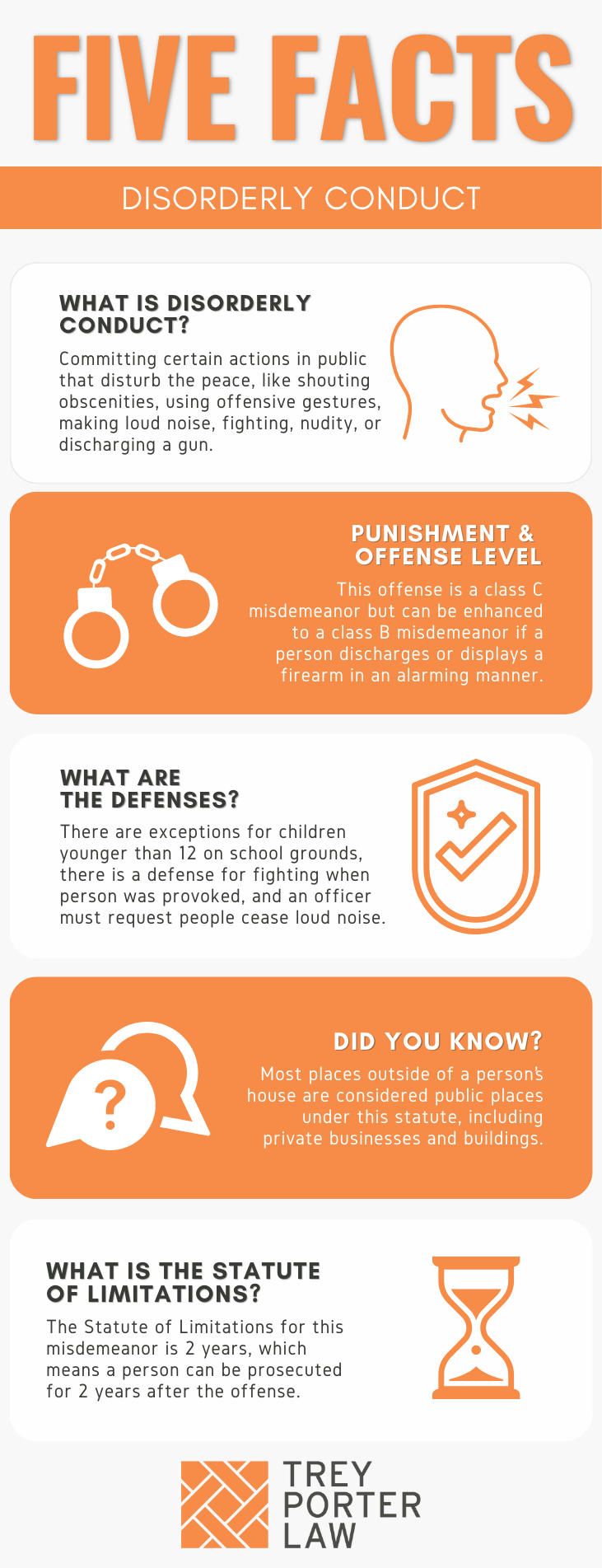WHAT IS DISORDERLY CONDUCT IN TEXAS?
Texas law prohibiting disorderly conduct criminalizes behavior that breaches the peace. Such behavior includes vulgar language, offensive gestures, creating harmful chemical odors, loud noise, fighting, nudity, or displaying or discharging a firearm. While most of the conduct prohibited by the disorderly conduct statute is legal in the privacy of one’s home, it is illegal in public when it incites a breach of the peace or is otherwise offensive.
- What is a breach of the peace? A breach of the peace is an act that disturbs or threatens to disturb the tranquility enjoyed by citizens. Texas courts have designated the following acts as breaches of the peace:
-
- Throwing things inside a store;
- Throwing a glass bottle at a car;
- Fighting in public;
- Flipping off a school principal during graduation;
- Driving while intoxicated;
- Public intoxication;
- Dangerous or reckless driving, such as speeding, swerving, and running into other cars;
- Criminal trespass;
- Indecent exposure.

WHAT IS THE DISORDERLY CONDUCT LAW IN TEXAS?
Tex. Penal Code § 42.01. DISORDERLY CONDUCT.
(a) A person commits an offense if he intentionally or knowingly:
(1) uses abusive, indecent, profane, or vulgar language in a public place, and the language by its very utterance tends to incite an immediate breach of the peace;
(2) makes an offensive gesture or display in a public place, and the gesture or display tends to incite an immediate breach of the peace;
(3) creates, by chemical means, a noxious and unreasonable odor in a public place;
(4) abuses or threatens a person in a public place in an obviously offensive manner;
(5) makes unreasonable noise in a public place other than a sport shooting range, or in or near a private residence that he has no right to occupy;
(6) fights with another in a public place;
(7) discharges a firearm in a public place other than a public road or a sport shooting range;
(8) displays a firearm or other deadly weapon in a public place in a manner calculated to alarm;
(9) discharges a firearm on or across a public road;
(10) exposes his anus or genitals in a public place and is reckless about whether another may be present who will be offended or alarmed by his act; or
(11) for a lewd or unlawful purpose:
(A) enters on the property of another and looks into a dwelling on the property through any window or other opening in the dwelling;
(B) while on the premises of a hotel or comparable establishment, looks into a guest room not the person’s own through a window or other opening in the room; or
(C) while on the premises of a public place, looks into an area such as a restroom or shower stall or changing or dressing room that is designed to provide privacy to a person using the area.
(b) It is a defense to prosecution under Subsection (a)(4) that the actor had significant provocation for his abusive or threatening conduct.
. . .
(d) An offense under this section is a Class C misdemeanor unless committed under Subsection (a)(7) or (a)(8), in which event it is a Class B misdemeanor.
(e) It is a defense to prosecution for an offense under Subsection (a)(7) or (9) that the person who discharged the firearm had a reasonable fear of bodily injury to the person or to another by a dangerous wild animal as defined by Section 822.101, Health and Safety Code.
(f) Subsections (a)(1), (2), (3), (5), and (6) do not apply to a person who, at the time the person engaged in conduct prohibited under the applicable subdivision, was a student younger than 12 years of age, and the prohibited conduct occurred at a public school campus during regular school hours.
Tex. Penal Code § 42.04. DEFENSE WHEN CONDUCT CONSISTS OF SPEECH OR OTHER EXPRESSION.
(a) If conduct that would otherwise violate Section 42.01(a)(5) (Unreasonable Noise), 42.03 (Obstructing Passageway), or 42.055 (Funeral Service Disruptions) consists of speech or other communication, of gathering with others to hear or observe such speech or communication, or of gathering with others to picket or otherwise express in a nonviolent manner a position on social, economic, political, or religious questions, the actor must be ordered to move, disperse, or otherwise remedy the violation prior to his arrest if he has not yet intentionally harmed the interests of others which those sections seek to protect.
(b) The order required by this section may be given by a peace officer, a fireman, a person with authority to control the use of the premises, or any person directly affected by the violation.
(c) It is a defense to prosecution under Section 42.01(a)(5), 42.03, or 42.055:
(1) that in circumstances in which this section requires an order no order was given;
(2) that an order, if given, was manifestly unreasonable in scope; or
(3) that an order, if given, was promptly obeyed.
WHAT IS THE PENALTY CLASS FOR DISORDERLY CONDUCT IN TEXAS?
Disorderly conduct in most circumstances is a Class C misdemeanor, punishable by up to a $500 fine. Disorderly conduct by discharging a firearm in a public place, or by displaying a firearm in public in a manner calculated to alarm, is a Class B misdemeanor, punishable by up to 180 days in jail.
- Is a disorderly conduct charge enhanceable? Yes. If a person is ticketed at least twice in two years for disorderly conduct, public intoxication, or a combination thereof, and commits either of those offenses a third time within the two-year period, the penalties are increased to a maximum fine of $2,000, and up to 180 days in jail.
WHAT IS THE PUNISHMENT RANGE FOR DISORDERLY CONDUCT IN TEXAS?
The punishment range for disorderly conduct charged as a Class C misdemeanor is a maximum fine of $500. If charged as a Class B misdemeanor, disorderly conduct carries up to 180 days in jail, and a maximum fine of $2,000.
WHAT ARE THE PENALTIES FOR DISORDERLY CONDUCT IN TEXAS?
A person charged with Class C misdemeanor disorderly conduct may avoid a conviction and be placed on deferred adjudication for up to 180 days. A person charged with Class B misdemeanor disorderly conduct may be eligible for probation after a conviction, or deferred adjudication without a conviction, for a period of up to two years.
- Is a person probation-eligible for an enhanced disorderly conduct charge? Yes. If a disorderly conduct ticket, ordinarily punishable as a Class C misdemeanor, is enhanced by two priors within two years, a person may be placed on probation for no more than two years. A person on probation for a third disorderly conduct or public intoxication conviction will be required, as conditions of probation, to submit to a psychological assessment, and testing for drug or alcohol addiction, and participate in any recommended treatment or education programs.
WHAT ARE THE DEFENSES TO DISORDERLY CONDUCT IN TEXAS?
There are several ways in which a person may defend against a disorderly conduct charge. The statute specifically exempts students younger than 12 on school grounds during regular school hours who:
- fight;
- use abusive, indecent, profane, or vulgar language, or make offensive gestures tending to incite a breach of the peace; or
- create a noxious chemical odor.
The law creates a defense for disorderly conduct by discharging a firearm if the accused fired the weapon in response to a reasonable fear of a wild animal.
- What if another person started it? While abusing or threatening a person in public is a crime, it is a defense if the accused “had significant provocation for his abusive or threatening conduct.” Threats are not protected speech, and may be prosecuted as disorderly conduct, or a terroristic threat under certain circumstances. However, if two people are screaming threats at each other in public, the statute gives both parties a defense to disorderly conduct charges.
- What are “fighting words” punished by the disorderly conduct law? Fighting words are words that tend to incite an immediate breach of the peace by their very utterance. The test is whether a person of common intelligence would understand the words or gestures as likely to cause the recipient to fight. Harsh, insulting, derisive, or annoying words or gestures are not “fighting words” unless they plainly tend to excite the addressee to a breach of peace. For example, yelling at a ten-year-old girl, “hey bitch, what are you looking at,” could have incited the girl’s parent, who was also present, to fight. See Ste-Marie v. State, 32 S.W.3d 446 (Tex. App.—Houston [14th Dist.] 2000, no pet.).
- Does an officer have to tell people to turn the noise down before charging them with disorderly conduct? Yes, if the “unreasonable noise” is nonviolent speech or other communication. Prior to arresting or charging a person with disorderly conduct by making unreasonable noise, an officer, firefighter, or other person affected by the conduct must order the person to remedy the violation. A person accused of making unreasonable noise may defend himself by showing no order was given in a situation that required it, or the given order was manifestly unreasonable, or promptly obeyed.
- What if a person charged with disorderly conduct by displaying a firearm is licensed to openly carry a firearm? A person does not commit disorderly conduct simply by lawfully exercising the right to openly carry a firearm. But that right is not without limits. The disorderly conduct statute specifically prohibits displaying a firearm in a public place “in a manner calculated to alarm,” which means a person may not intentionally display a firearm in a way that is objectively likely to frighten an ordinary, reasonable person.
WHAT IS THE STATUTE OF LIMITATIONS FOR DISORDERLY CONDUCT IN TEXAS?
The limitation period for disorderly conduct is two years.
DISORDERLY CONDUCT IN TEXAS
Disorderly conduct under Texas law occurs when a person intentionally or knowingly creates a public inconvenience or annoyance, or otherwise breaches the peace.
TEXAS DISORDERLY CONDUCT COURT CASES
The case law regarding disorderly conduct in Texas illustrates the statute’s application and constitutionality.
In one case, a defendant was stopped for disorderly conduct after she flipped off other drivers who honked at her, and mouthed profanities. The officer realized the defendant had been drinking, and she was arrested for driving while intoxicated. The trial court suppressed the traffic stop, ruling that the defendant’s gestures were not “fighting words.” The court of appeals recognized it is “common knowledge that this gesture and these words mouthed by a Texas motorist has led to breaches of the peace and even the loss of life.” However, it upheld the trial court’s decision that in this case, it was not disorderly conduct. State v. Rivenburgh, 933 S.W.2d 698 (Tex. App.—San Antonio 1996, no pet.).
The Court of Criminal Appeals has discussed the meaning of “public place” in the disorderly conduct context. A defendant was charged with disorderly conduct for public nudity on a remote, secluded beach, with 100 other nudists. A man and his family were fishing on the beach, and were offended by the nudity. The Court upheld the defendant’s disorderly conduct conviction, explaining there was no exception to the public place requirement for remote or secluded areas. Most areas outside a person’s home may be considered a public place. Lacour v. State, 8 S.W.3d 670 (Tex. Crim. App. 2000).
















